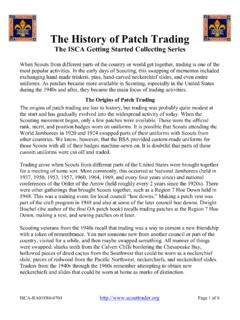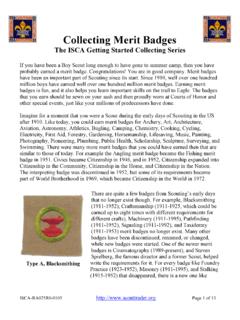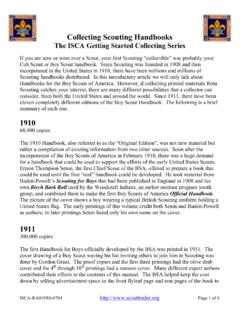Transcription of Collecting OA Patches - International Scouting …
1 ISCA-RA005R0-0604 Page 1 of 11 Collecting OA Patches The ISCA Getting Started Collecting Series Order of the Arrow (OA) patch Collecting is very popular. In fact, it is probably the most popular specialization. Almost everyone who collects Boy Scout Patches has at least a small OA collection. Most people start by saving a flap from their lodge. Then they keep buying the new issues as they come out. If you buy an extra patch each time, then you will have duplicate Patches to trade in the future. Next, you can try to obtain older issues and activity Patches from your lodge. Your local OA lodge functions, fellowships, pow-wows, and area conclaves are usually a good source for older Patches . Other sources include Trade-O-Rees, eBay, Jamborees, and National OA Conferences. Once you get started Collecting your own lodge, it is easy to get interested in other lodges. Many collectors collect Patches from nearby lodges such as the other lodges in their section, state, or region.
2 Some collectors only specialize in certain lodges or regions. Others collect Patches nationally. For example, some collectors try to get a patch from every name or number. The first lodge is Unami Lodge #1 from Philadelphia, Pennsylvania, which was founded by E. Urner Goodman and Carroll Edson. The next lodge was Lodge #2, which briefly chartered under the name Trenton before rechartering as Sanhican. Lodge #3 briefly chartered as Pamunkey before changing to Nawakwa. Lodge #4 is Ranachqua. Lodge #5 has had the names Indiandale, Minsi, and Kittatinny. A Solidly-Embroidered Flap-Shaped Patch, Malibu Lodge, S-1 A Round Patch, Unami Lodge, R-8 ISCA-RA005R0-0604 Page 2 of 11 There are many more lodges. Every number up to 567 has been used along with a few larger numbers: 578, 614, 617, 618, and 619. Not all lodges issued Patches , however. Among the first five numbers, Unami, Sanhican, Nawakwa, Ranachqua, Minsi, and Kittatinny issued Patches , while Trenton, Pamunkey, and Indiandale probably did not.
3 Some early lodges only issued neckerchiefs or non-flap shaped Patches . Number collectors try to get a patch from all numbers, so obtaining either a Lodge #5 Minsi or a Lodge #5 Kittatinny is sufficient for a pure numbers collector. Note that there is not a patch for every number. Other collectors try to get a patch from every name and number. Lodges have had numbers throughout most of our OA history, from 1915 through 2003, but recently, the national OA committee eliminated lodge numbers. It is quite likely, however, that lodges will continue to use their historical numbers for a long time to come. Wapiti Lodge, First Flap, Geer Shaped, F-1, Cut Edge Mide Lodge, First Flap Moritz Shaped, F-1, Flat Rolled Edge A Woven Flap, Black Eagle Lodge in Europe, W-1 ISCA-RA005R0-0604 Page 3 of 11 Some collectors just collect one patch from each lodge, some collect a few, and some collect every issue. Some just collect older issues; some collect newer issues.
4 Some lodge issues are especially sought after. The first flap-shaped patch from each lodge is called a first flap. First flaps are highly collectible and are usually more desirable than even rarer issues that may have come later. The lodge s first odd shape (round, arrowhead, square, dome, shield, and so on, any shape but flap shaped) is also very collectible. Some people like the first solidly-embroidered flap. Some people like Vigil flaps. There were a few patch manufactures in particular that made many of the early flaps. Some made by the Geer, Moritz, or Lion Brothers Companies are recognizable by their distinctive shapes. Some people are particularly interested in flaps from a particular manufacturer such as Geer. Some people collect Patches with a certain theme like flaps with birds or buffaloes or just Patches that look cool. Getting one patch from every lodge in your state or section is probably going to be pretty easy. Getting one patch from every current lodge (several hundred) is hard but doable.
5 Complete number sets are very expensive, and complete name sets are almost impossible, although a couple do exist. A Chenille, Scarouady Lodge, C-1 An Odd Shaped Patch, Cuyahoga Lodge, X-1 ISCA-RA005R0-0604 Page 4 of 11 When you hear collectors talking about Patches , you will hear lots of letters and numbers: A-1, F-2, S-3, and so on. This is how Patches are described. S means solidly embroidered and flap-shaped. F refers to a flap where part of the background is cloth or twill. A means arrowhead, C means chenille, R means round, J means jacket patch, P means pie-shaped for a neckerchief, and X means any other shape. The first F is F-1, the second is F-2, and so on. We often say knowledge is key! This means that it is important to learn as much as you can about the area you collect. The more you know, the better you can do, both in life and in Collecting . Most older traders are glad to help you learn.
6 Also, there are books about OA Patches and about many other areas of Collecting . Ask other traders to show you their books. Eventually, as your collection grows, you will want to obtain some books yourself. Every OA collector should have a Pocket Blue Book. The Pocket Blue Book contains a picture of one patch from every lodge, past and present along with other useful information. You can usually just trade a single flap for one. As you become interested in issues, you should get the full Blue Book. The Blue Book is a two-volume reference work that lists every issue of every lodge. A Solidly-Embroidered Flap, Unilachtego Lodge, S-1, Rolled Edge An Arrowhead-Shaped Patch, Carcajou Lodge, A-1, Cut Edge ISCA-RA005R0-0604 Page 5 of 11 A fantastic site for information about OA Patches is John Pannell s site on the web It contains Blue Book information and at last count, 36,881 images from 767 lodges.
7 This is a great place to see a lot of the old issues from your lodge and other great Patches that you would otherwise never see unless you were lucky enough to see a major collection. When you begin trading, just trade one-for-one: one of yours for one of theirs. If someone wants two for theirs or ten for theirs, find someone else to trade with. As your knowledge grows, and you learn which Patches are more valuable and which are more common, you can start acquiring more valuable Patches . There are thousands of OA Patches that you can get with a one-for-one trade. Don t worry that you may not get a certain cool patch that you really like. You will almost certainly find it available again. Some flaps are restricted, which means that the number that you can buy is limited. Some flaps may be one or two per OA advancement (Ordeal, Brotherhood, and Vigil) or one awarded for every so many hours of service. Restrictions were more common years ago, but some lodges still restrict their Patches .
8 If your Patches are restricted, do not trade them one for one for unrestricted Patches . You are better off getting unrestricted Patches A Solidly-Embroidered Flap, Netopalis Sipo Schipinachk Lodge, S-1, Rolled Edge, a New Lodge A Solidly-Embroidered Flap, Witauchsundin Lodge, Geer Shaped, S-1, Cut Edge ISCA-RA005R0-0604 Page 6 of 11 to trade and hanging on to your restricted Patches until you have a better understanding of their value. Remember, knowledge is key! One of the hard parts about patch Collecting is getting duplicate Patches (often called dups, which rhymes with oops ) to trade. OA flaps from your own council may cost a lot of money. Flaps costing more than 3 or 4 dollars each are not unusual. Watch for good deals. Sometimes conclave flaps or NOAC flaps will be a cheaper way to get trading stock. If you can buy extra lodge activity Patches for less than you pay for lodge flap, you can usually trade them later for flaps.
9 Every big collector started as a small collector. The most important thing to remember when you are starting out is to trade one for one, learn as much as you can, keep your collection clean and safe, and have fun! -- Warren F. KuhfeldA NOAC Two-Piece Set, Occoneechee Lodge, S-32 & X-12 ISCA-RA005R0-0604 Page 7 of 11 A Pie-Shaped Neckerchief Patch, Miami Lodge, P-1, Rolled Edge ISCA-RA005R0-0604 Page 8 of 11 Some people collect the First Flap from each lodge. A few of the older lodges never issued flap-shaped Patches . ISCA-RA005R0-0604 Page 9 of 11 Some lodges such as Tahawus Lodge 32 only issued a neckerchief. ISCA-RA005R0-0604 Page 10 of 11 Flaps issued for a National OA Conference are often less serious and more fun than regular issues.
10 ISCA-RA005R0-0604 Page 11 of 11 Lodge conclave flaps, like NOAC flaps are often less serious and more fun than regular issues.








